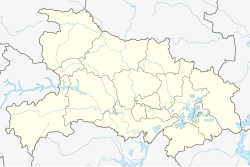This article needs additional citations for verification. (August 2016) |
Dangyang
当阳市 Tangyang | |
|---|---|
 Dangyang Yuquan Temple | |
 Dangyang is the easternmost division on this map of Yichang | |
| Coordinates: 30°49′16″N 111°47′20″E / 30.821°N 111.789°E | |
| Country | People's Republic of China |
| Province | Hubei |
| Prefecture-level city | Yichang |
| Area | |
| 2,038 km2 (787 sq mi) | |
| • Urban | 220.30 km2 (85.06 sq mi) |
| Population (2020)[3] | |
| 397,465 | |
| • Density | 200/km2 (510/sq mi) |
| • Urban | 224,057 |
| Website | hbdy |
Dangyang (simplified Chinese: 当阳; traditional Chinese: 當陽; pinyin: Dāngyáng) is a city in western Hubei province, People's Republic of China, lying 70 kilometres (43 mi) east of the Gezhouba Dam on the Yangtze River. During the Western Han dynasty (206–24 BC). Emperor Jing of Han established an administration in Dangyang on an area of 2,000 square kilometres (770 sq mi). In 1988 the State Council of the People's Republic of China elevated this from a county to a county-level city, and is currently under the administration of the prefecture-level city of Yichang.[1]
Dangyang used to be a strategic point in ancient wars. Sun Bin and Pang Juan, two famous strategists of the Warring States period (475–221 BC) studied military affairs from Gui Guzi at Daxian Cave in Dangyang. The Green Woods Uprising was launched in Dangyang and several battles were fought in Dangyang during the Three Kingdoms period (AD 220–280).
Today Dangyang is a rapidly growing modern city with a population of over 100,000. While agriculture remains a key industry in Dangyang, industrial production now includes output in the areas of foodstuffs, building materials, textiles, chemicals, electronics, machinery, energy and packaging.
On August 11, 2016, an explosion at a chemical factory in Dangyang killed 21 people and injured at least 5.[4]
- ^ a b Cite error: The named reference
xzqhdywas invoked but never defined (see the help page). - ^ Ministry of Housing and Urban-Rural Development, ed. (2019). China Urban Construction Statistical Yearbook 2017. Beijing: China Statistics Press. p. 66. Archived from the original on 18 June 2019. Retrieved 11 January 2020.
- ^ "China: Húbĕi (Prefectures, Cities, Districts and Counties) - Population Statistics, Charts and Map". www.citypopulation.de. Retrieved 2024-11-22.
- ^ News, 163.com. 湖北当阳一公司爆炸 (in Simplified Chinese). Retrieved 12 August 2016.
{{cite news}}:|last1=has generic name (help)CS1 maint: numeric names: authors list (link)
